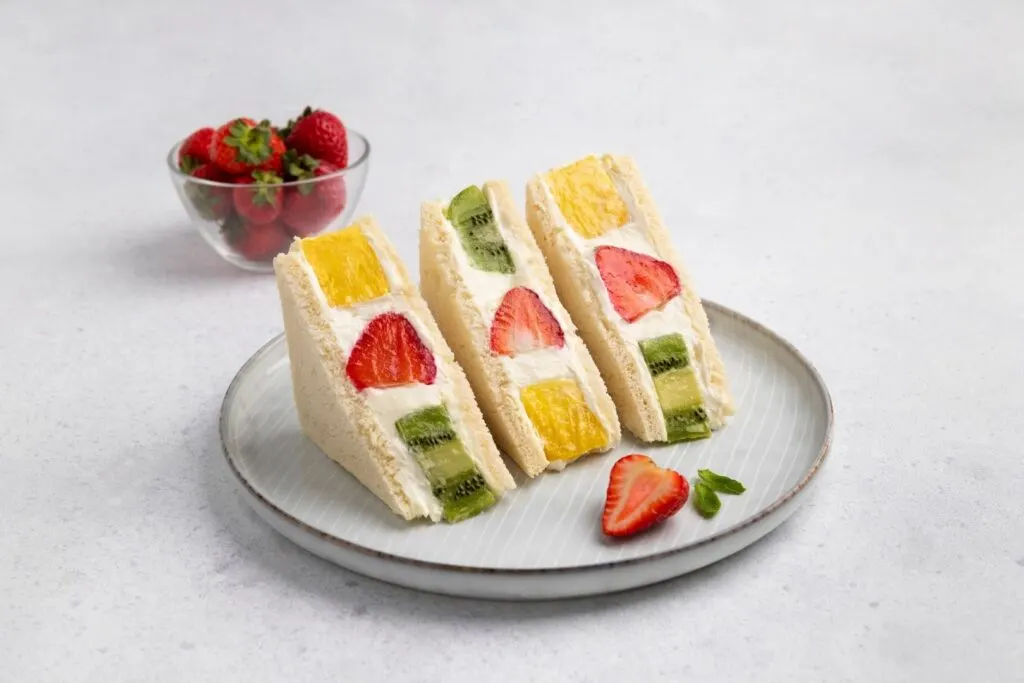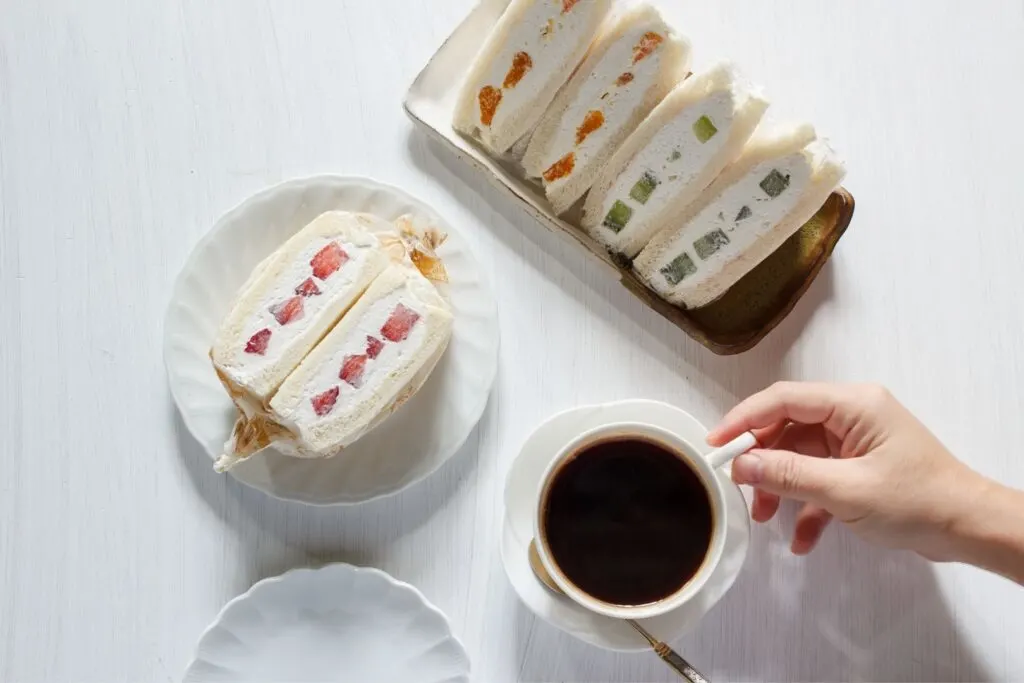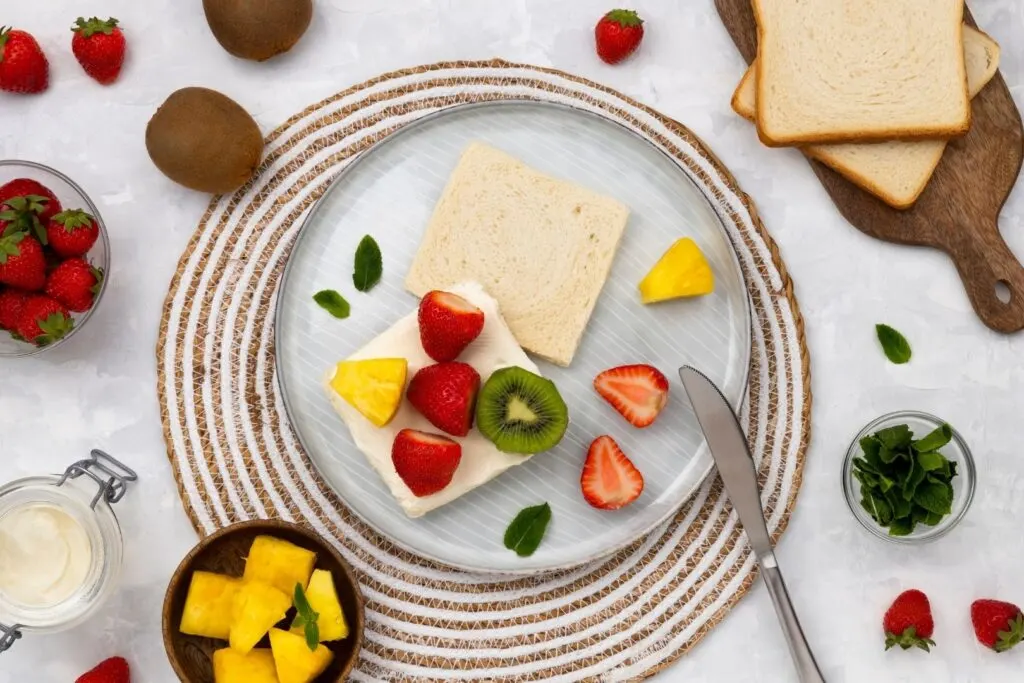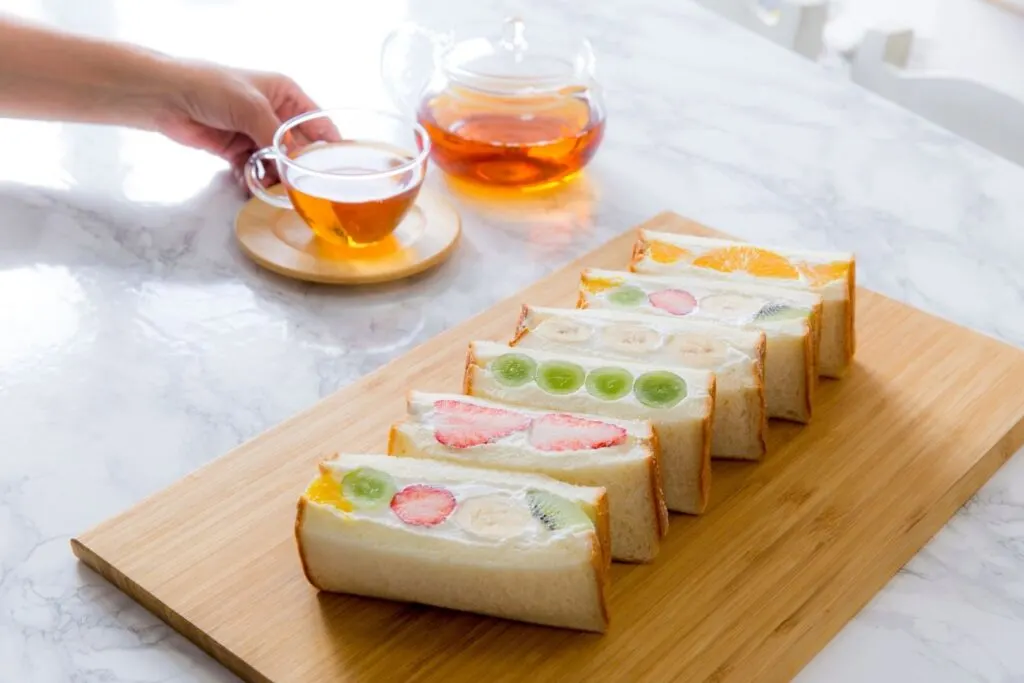When perusing the selection of sandwiches on offer in Japan, there’s one type that will no doubt cause a double-take and make you re-assess your definition of what constitutes a sandwich filling.
Two pieces of white bread filled with whipped cream and fruits is not only available, it’s become a typical food item that is considered quintessentially Japanese.
While the ingredients are simple, Japanese fruit sandwiches have an interesting and ever-evolving history.
In this article, we’ll delve into the origin and evolution of the “fruit sando,” and where you can try this interesting cultural delight in the country’s capital.

Table of Contents
The History of Japanese Fruit Sandwiches
The fact that fruits are expensive in Japan is no secret. They were (and at times continue to be) a luxury in Japan, and while they became more commonly accessible to the public during the Taishō era (1912-1926), they were mostly bought for gifts (both personal and business) or special occasions. Due to this, many fruit shops opened near major train stations and business districts in the early 1900s.
Japan loves to gift, so as the fruit shop business grew, many began to open fruit parlors, a cafe adjacent to the shop which served various fruit dishes such as parfaits and shortcakes. This allowed the public to access luxury fruits at a reasonable price.
One of the most popular dishes that was born from this trend is the fruit sandwich, more commonly known as “fruits sando” (furutsu sando, フルーツサンド) in Japanese.
As history can be, there are various theories about where exactly the first fruit sando originated. The most common understanding is that it was either in Tokyo or Kyoto, where many fruit shops were located due to both cities being a central business and administrative location.
In the case of Tokyo, the famous high-end fruits shop Sembikiya opened its main Nihonbashi shop in 1834, and began operating the first ever fruits parlor in 1894. Likewise in Kyoto, one of the oldest fruits shops, Yaoiso, which opened in 1869, established a fruit parlor in 1972.
Both these fruit parlors remain today and have kept Japanese fruit sandwiches on their menus.
Different Styles of Fruit Sando Over the Years
Originally the fruit sandwiches were a way for the fruit shops to control their stock, so many of them used multiple fruits, often cut into small slices, in their creations.
They were also originally cut into squares, in a British sandwich style. Nowadays, you’ll more often than not see sandwiches cut into triangles.

Interestingly, diagonally-cut sandwiches only became popular in the post-war era in Japan. This came about in 1961, when the owners of Furenpan bakery decided to cut their sandwich diagonally, to better show off the sandwich filling and to make it easier for people to eat.
They even patented this way of cutting the sandwiches, as well as the triangle sandwich wrappers. But later, with the 1964 Tokyo Olympics approaching, they let go of the patent in hopes that more people would eat the triangle sandwiches at the Games. It caught on, and through the Olympics it’s said that the popularity of diagonally-cut sandwiches increased nationwide.
Indeed the look of the sandwich once cut is a key component of Japanese fruit sandwiches today, which is just as much about visual delight as it is taste. Nowadays having large chunks of fruit that have been strategically placed between the bread and cream for maximum impact is more common and favored over the smaller slices of the past. This can be pointed to the popularity of 萌え断 (mo-eh-dan, meaning “desirable cross section”), where people enjoy the beauty of a cleanly-cut sandwich.
Over the years, the availability of Japanese fruit sandwiches has grown, and they can now be found in not only fruit parlors, but also cafes and bakeries. With its recent popularity, even being crowned the number 1 food and drink trend in 2021 by users of the Retty restaurant review app in their ‘Trend Gourmet’ survey, fruit sando can also be found in your local conbini!

Recommended Japanese Fruit Sandwich Shops
Today, fruit sandwich shops can be separated into three categories.
One is the traditional fruit parlors, which is where fruit sando came to be, and still remains popular to this day. It’s where people go for special occasions, such as celebrations or dates.
Second are the cafes and bakeries, with the number offering Japanese fruit sandwiches growing alongside the popularity of the item. Their fruit sando range from classic to unique menus.
Finally, a more recent trend is take-out fruit sando specialty shops. Unlike the original luxury fruits of yore, the increase in people gifting fruit sandwiches has paved the way for more economical take-out stands that have been popping up all over the capital.
Below are some recommendations for where to get your Japanese fruit sandwich fix in and around Tokyo.

Traditional Fruit Parlors
Sembikiya Tokyo (Nihonbashi / Ikebukuro / Marunouchi / Yokohama)
The first ever fruit parlor to open in Tokyo, Sembikiya has been introducing luxury fruit sandwiches to the public for around a century. Their mixed fruit sandwiches, filled with cut strawberries, mangoes and kiwis, will fill your mouth with delight.
Takano Fruit Parlor (Shinjuku / Ikebukuro / Yokohama / Kawagoe / Nagoya)
The main fruit parlor was established in 1926, adjacent to the Takano fruit shop, which opened its doors in 1885, the same year the world-famous Shinjuku Station was completed. The fruit sando was on their menu when it first opened, and the original mixed fruit sandwiches continue to remain on the menu to this day.
Nishimura Fruits Parlor (Shibuya / Machida)
One of the landmarks of Shibuya, Nishimura opened its doors as a high-end fruits shop in 1910. The fruit parlor opened in 1936 and has been popular amongst many generations since then. Their strawberry fruits sando is a classic, and also surprisingly filling.
Cafes and Bakeries
INITIAL (Omotesando / Nakameguro)
If you’re looking for the ultimate whimsical fruit sandwich, this parfait cafe is for you. Not only are their flower-patterned fruits sando a delight, the shop is also open until 11pm to accommodate your late night cravings!
Jules Verne Coffee (Koenji)
This is a specialty coffee shop, but they also serve a limited 40 fruit sandwiches per day on a first-come first-served basis. Their mixture of fruits and flavored cream is unique, such as mikan (Satsuma mandarin orange) plus persimmon with cassis cream. As a coffee lover, this cafe is a must.
Fruits du Saison (Akihabara)
Located on a quiet street in Akihabara, this old-school café is known for their fruit parfaits…but don’t overlook their croissant sandwich set. The croissants, which they bake at the café every morning, along with their fresh fruits, take the fruit sando to the next level. And not only does the croissant sandwich set come with coffee or tea, but also a side of (…wait for it…) fruits!
Fruit Shop Stands for Take-out
Daiwa (Nakameguro)
The local produce market in Aichi, Daiwa Super, famous for their dynamic fruit sandwiches, opened their first Tokyo specialty shop in spring 2020. You will recognize the shop as the one where people gather, but don’t let the long lines scare you away; the fruit sandwiches will not disappoint. The seasonal fruits and the citrus Setoka are my favorite!
Nagiya Tokyo (Shinjuku)
Opened in summer 2021, Nagiya is produced by shokupan (white square-shaped sandwich bread) specialty shop, Tokyo Noarezan. For Nagiya’s take on Japanese fruit sandwiches, their flagship menu item, honey cream bread, is combined with subtle fresh cream and fruits carefully chosen by the shop owner. Both the flavor and the details of this fruit sando will bring a smile to your face.
haluuu (Todoroki)
If you enjoy nature and fruit sandwiches, this take-out shop is for you. On their menu are popular fruits like pineapple and kiwi, as well as seasonal fruits such as the ever-popular green Shine Muscat grapes. The shop will also lend you a basket so you can take the sandwiches and enjoy a picnic at the Todoroki ravine, just a 10 minute walk away!
fruits and season (Ebisu)
My personal favorite, this is the first ever vegan fruit sandwich shop in Japan. The cream and bread are soy based and the sweetness is adjusted to accent the natural flavor of the fruit. And as they only have ⅓ calories of a regular fruits sando, there’s no reason not to give it a try!
While it may seem like the popularity is recent, fruit sandwiches have been around for more than 100 years in Japan, and if you’ve ever enjoyed the sweet trinity combo, you’ll know that the trend is here to stay!
Have you had fruit sando? Which style would you try?
Looking for other interesting food and drink items in Japan? Check out Japanese craft cola.
Pin me for later

Kaori is a Japanese salary woman by day, a passionate jump roper by night. She is originally from Okinawa but grew up in Michigan, Sapporo and Hiroshima.
A vegetarian who is currently based in Tokyo, she loves to spend time outdoors under the sun and take photos of everyday life in this big city.
